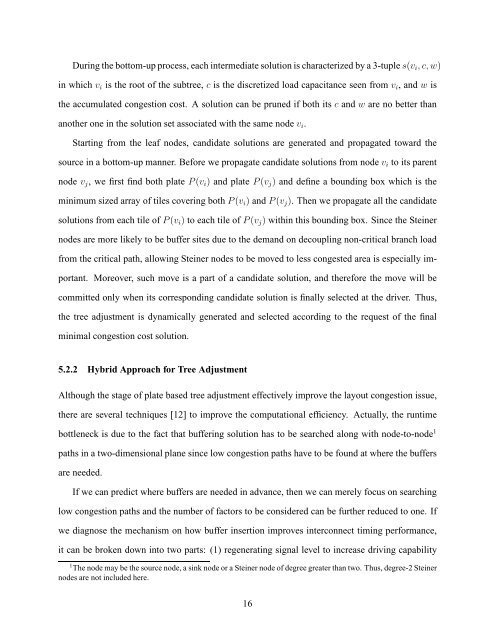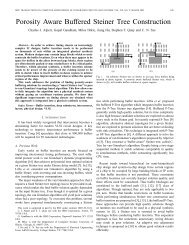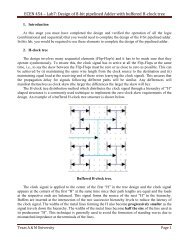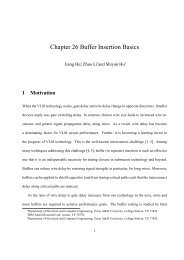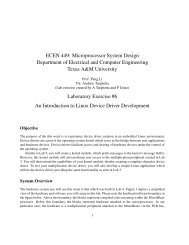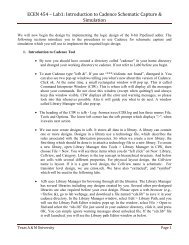Buffering in the Layout Environment - Computer Engineering ...
Buffering in the Layout Environment - Computer Engineering ...
Buffering in the Layout Environment - Computer Engineering ...
Create successful ePaper yourself
Turn your PDF publications into a flip-book with our unique Google optimized e-Paper software.
Dur<strong>in</strong>g <strong>the</strong> bottom-up process, each <strong>in</strong>termediate solution is characterized by a 3-tuple s(v i , c, w)<strong>in</strong> which v i is <strong>the</strong> root of <strong>the</strong> subtree, c is <strong>the</strong> discretized load capacitance seen from v i , and w is<strong>the</strong> accumulated congestion cost. A solution can be pruned if both its c and w are no better thanano<strong>the</strong>r one <strong>in</strong> <strong>the</strong> solution set associated with <strong>the</strong> same node v i .Start<strong>in</strong>g from <strong>the</strong> leaf nodes, candidate solutions are generated and propagated toward <strong>the</strong>source <strong>in</strong> a bottom-up manner. Before we propagate candidate solutions from node v i to its parentnode v j , we first f<strong>in</strong>d both plate P(v i ) and plate P(v j ) and def<strong>in</strong>e a bound<strong>in</strong>g box which is <strong>the</strong>m<strong>in</strong>imum sized array of tiles cover<strong>in</strong>g both P(v i ) and P(v j ). Then we propagate all <strong>the</strong> candidatesolutions from each tile of P(v i ) to each tile of P(v j ) with<strong>in</strong> this bound<strong>in</strong>g box. S<strong>in</strong>ce <strong>the</strong> Ste<strong>in</strong>ernodes are more likely to be buffer sites due to <strong>the</strong> demand on decoupl<strong>in</strong>g non-critical branch loadfrom <strong>the</strong> critical path, allow<strong>in</strong>g Ste<strong>in</strong>er nodes to be moved to less congested area is especially important.Moreover, such move is a part of a candidate solution, and <strong>the</strong>refore <strong>the</strong> move will becommitted only when its correspond<strong>in</strong>g candidate solution is f<strong>in</strong>ally selected at <strong>the</strong> driver. Thus,<strong>the</strong> tree adjustment is dynamically generated and selected accord<strong>in</strong>g to <strong>the</strong> request of <strong>the</strong> f<strong>in</strong>alm<strong>in</strong>imal congestion cost solution.5.2.2 Hybrid Approach for Tree AdjustmentAlthough <strong>the</strong> stage of plate based tree adjustment effectively improve <strong>the</strong> layout congestion issue,<strong>the</strong>re are several techniques [12] to improve <strong>the</strong> computational efficiency. Actually, <strong>the</strong> runtimebottleneck is due to <strong>the</strong> fact that buffer<strong>in</strong>g solution has to be searched along with node-to-node 1paths <strong>in</strong> a two-dimensional plane s<strong>in</strong>ce low congestion paths have to be found at where <strong>the</strong> buffersare needed.If we can predict where buffers are needed <strong>in</strong> advance, <strong>the</strong>n we can merely focus on search<strong>in</strong>glow congestion paths and <strong>the</strong> number of factors to be considered can be fur<strong>the</strong>r reduced to one. Ifwe diagnose <strong>the</strong> mechanism on how buffer <strong>in</strong>sertion improves <strong>in</strong>terconnect tim<strong>in</strong>g performance,it can be broken down <strong>in</strong>to two parts: (1) regenerat<strong>in</strong>g signal level to <strong>in</strong>crease driv<strong>in</strong>g capability1 The node may be <strong>the</strong> source node, a s<strong>in</strong>k node or a Ste<strong>in</strong>er node of degree greater than two. Thus, degree-2 Ste<strong>in</strong>ernodes are not <strong>in</strong>cluded here.16


